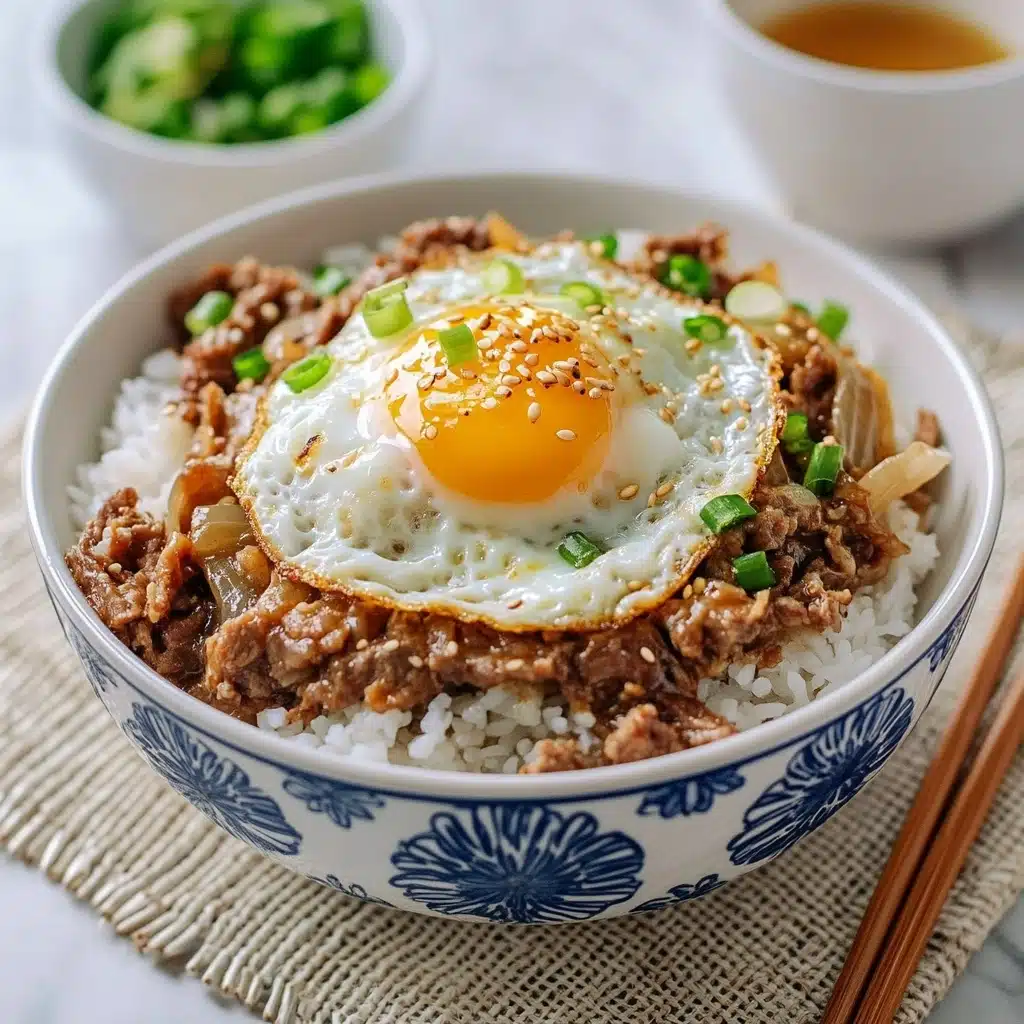I absolutely love how comforting and quick this Gyudon (Japanese Beef & Rice Bowls) Recipe is. It’s one of those dishes that feels like a warm hug on a busy weeknight but still tastes wonderfully authentic and satisfying. The tender, thinly sliced beef simmered with onions and a savory-sweet sauce over steaming rice is pure magic—you’ll find it perfect when you want a hearty meal that doesn’t take forever to make.
When I first tried making gyudon at home, I was blown away by how simple ingredients come together to create deep, rich flavors reminiscent of small Japanese eateries. This recipe is worth trying because once you nail the balance of sweet, salty, and umami, it quickly becomes a go-to comfort food that everyone in my family goes crazy for.
Why You’ll Love This Recipe
- Fast and Easy: You can have this delicious bowl on your table in about 40 minutes with minimal fuss.
- Authentic Flavor: The use of mirin, soy, and dashi stock creates that classic Japanese balance of sweet and savory you’re craving.
- Versatile Ingredients: The recipe works well with common pantry items and can be easily adapted to what you have on hand.
- Family-Friendly: My kids and guests always ask for seconds—and you’ll find it turns into a staple in your weeknight dinner rotation.
Ingredients You’ll Need
I love that the ingredients for this Gyudon (Japanese Beef & Rice Bowls) Recipe are simple and easy to find, yet work beautifully together to create such a flavorful dish. When shopping, try to look for very thinly sliced beef, which is key to getting that tender, melt-in-your-mouth texture.
- Neutral oil: Choose vegetable or canola oil for a neutral taste that won’t compete with the sauce flavors.
- Onions: Very thinly sliced to soften and sweeten as they cook down with the beef.
- Thinly sliced beef: I prefer fatty beef chuck or ribeye for richness, but you can substitute with what’s available.
- Sugar: Just enough to balance the salty soy and deepen the sauce flavor.
- Mirin: This sweet cooking rice wine adds a lovely glaze and authentic touch.
- Soy sauce: The backbone of the umami flavor; adjust the amount to taste.
- Dashi stock: Classic Japanese broth base, but beef or chicken stock works if you prefer.
- Eggs: Cooked sunny-side up with runny yolks for that luscious topping.
- Cooked white rice: Short or medium grain rice is best for a sticky texture that holds up well with the sauce.
- Scallion: Chopped for a fresh, herbal garnish.
- Toasted sesame seeds (optional): Adds a subtle nutty crunch and visual appeal.
Variations
I love how flexible this Gyudon (Japanese Beef & Rice Bowls) Recipe can be, so feel free to switch things up based on what you enjoy or have in your pantry. I often tweak the toppings or swap the beef for different kinds of protein depending on the season or cravings.
- Add Mushrooms: I once added shiitake mushrooms to the simmering beef mixture, which brought an earthy depth that really boosted the umami.
- Use Ground Beef: For a more budget-friendly variation, ground beef works well, though the texture differs slightly from thinly sliced beef.
- Vegetarian Version: Swap beef for thinly sliced tofu or mushrooms with vegetable broth for a meatless twist.
- Spicy Kick: Add a dash of shichimi togarashi or chili flakes to the sauce for a little heat that livens up the bowl.
How to Make Gyudon (Japanese Beef & Rice Bowls) Recipe
Step 1: Slowly Cook the Onions for Maximum Sweetness
Start by heating the neutral oil in a large skillet over medium-high heat. Add the very thinly sliced onions and cook them for about 10 minutes, stirring often. This slow cooking breaks down the onions, bringing out their natural sweetness, which is crucial for the signature flavor of gyudon. Don’t rush this step — those caramelized onions make all the difference!
Step 2: Add Beef and Build Flavor with Sauce Ingredients
Once the onions are soft and sweet, add the thinly sliced beef and sugar. Cook just until the beef starts to brown slightly — you want it lightly caramelized, not overcooked. Stir in the mirin, soy sauce, and dashi stock, then bring everything to a simmer. Let it cook gently for about 10-15 minutes, so the liquid reduces into a flavorful, thin sauce. Taste and adjust the soy sauce as needed; sometimes a little extra saltiness amps up the flavor perfectly.
Step 3: Prepare the Perfect Sunny-Side-Up Eggs
While the beef simmers, heat a couple tablespoons of oil in a non-stick or cast iron skillet for the eggs. Cook them sunny-side up with the yolks still runny — this rich, runny yolk melds beautifully with the savory beef and rice. I usually cook in batches if my pan isn’t big enough, and it’s worth the little effort for that luxurious finishing touch.
Step 4: Assemble the Bowls for Serving
Divide the hot cooked rice among four bowls. Spoon the simmered beef and onions over the rice, then top each bowl with a sunny-side-up egg. Garnish with chopped scallions and sprinkle toasted sesame seeds if you like that extra nutty crunch. Serve immediately for the best flavors and texture—you’ll love how the yolk creates a luscious sauce when mixed into the beef and rice!
Pro Tips for Making Gyudon (Japanese Beef & Rice Bowls) Recipe
- Use Very Thinly Sliced Beef: I discovered this trick when I bought pre-sliced beef at an Asian market — it cooks quickly and stays tender without drying out.
- Simmer Gently: Slow simmering reduces the broth perfectly without toughening the meat, keeping it juicy and flavorful.
- Don’t Skip the Onions: They add natural sweetness that balances the salty soy sauce, making the sauce taste rich and well-rounded.
- Cook Eggs Separately: Avoid crowding the pan so each egg cooks evenly with a perfectly runny yolk—don’t rush this step!
How to Serve Gyudon (Japanese Beef & Rice Bowls) Recipe

Garnishes
I usually keep it simple with chopped scallions for a fresh bite and toasted sesame seeds to add a subtle nutty aroma. Sometimes, I like to add a little pickled ginger on the side—it cuts through the richness and adds a nice zing that wakes up your palate.
Side Dishes
This bowl pairs wonderfully with a light cucumber sunomono salad or miso soup to round out the meal with some refreshing and umami-packed sides. I’ve also served it alongside steamed or roasted vegetables, which balances the richness of the beef nicely.
Creative Ways to Present
For special occasions, I’ve tried serving gyudon in individual donburi-style wooden bowls for an authentic touch. Adding a soft-boiled egg instead of sunny-side up eggs also makes it a bit more elegant. Sometimes, I drizzle a little extra soy or sprinkle nori strips over the top for visual flair and added flavor. It’s fun to get creative!
Make Ahead and Storage
Storing Leftovers
I store any leftover beef mixture separately in an airtight container in the fridge for up to 3 days. Keeping the beef and rice separate helps maintain texture and flavor integrity. When I reheat, it feels almost as good as fresh!
Freezing
I have frozen the cooked beef mixture before without issues—just cool it completely, then freeze in portions. When thawed and reheated gently, it still tastes great. I don’t freeze the rice or eggs though, as the texture suffers.
Reheating
To reheat, I warm the beef gently in a pan or microwave to avoid drying it out. I re-steam leftover rice briefly to bring back some moisture. For eggs, I prefer to make fresh sunny-side-ups each time — they’re quick and make the meal feel freshly made!
FAQs
-
Can I make Gyudon (Japanese Beef & Rice Bowls) Recipe with other types of meat?
Absolutely! While thinly sliced beef chuck or ribeye is traditional, you can use ground beef, thinly sliced pork, or even chicken thighs sliced thinly. Just adjust cooking times accordingly to avoid overcooking.
-
What can I use if I don’t have dashi stock?
If you don’t have dashi stock, you can substitute with beef or chicken stock, or even a mild vegetable stock. While dashi adds a unique umami, these alternatives still give the dish great depth of flavor.
-
How do I make sure the beef stays tender?
The key is using very thinly sliced beef and simmering it gently without overcooking. Keep an eye on the texture and avoid boiling aggressively—it should stay tender and juicy.
-
Can I prepare this recipe in advance?
You can prepare the beef and onion mixture ahead of time and reheat it when ready to serve. Just cook fresh eggs and rice before serving for the best texture.
Final Thoughts
This Gyudon (Japanese Beef & Rice Bowls) Recipe has become such a beloved dish in my house—comforting, easy, and full of authentic flavor. I can’t recommend it enough if you want a quick, satisfying Japanese-inspired meal that brings everyone together around the table. Give it a try; I’m sure you’ll find yourself making it again and again just like me!
Print
Gyudon (Japanese Beef & Rice Bowls) Recipe
- Prep Time: 10 minutes
- Cook Time: 30 minutes
- Total Time: 40 minutes
- Yield: 4 servings
- Category: Main Dish
- Method: Stovetop
- Cuisine: Japanese
Description
Gyudon is a classic Japanese comfort dish featuring thinly sliced beef simmered with onions in a savory-sweet sauce made from soy sauce, mirin, and dashi stock, served over a bed of fluffy white rice and topped with a perfectly cooked sunny-side-up egg. This recipe offers a quick and satisfying meal that’s rich in umami flavors and perfect for a hearty lunch or dinner.
Ingredients
Main Ingredients
- Neutral oil (such as vegetable or canola oil) – 2 tablespoons
- 2 medium onions, very thinly sliced
- 1 pound very thinly sliced beef (fatty beef chuck or ribeye)
- 2 teaspoons sugar
- 2 tablespoons mirin
- 2 tablespoons soy sauce
- 1 cup dashi stock (can substitute beef or chicken stock)
- 4 eggs
- 4 cups cooked white rice (short grain or medium grain preferred)
- 1 scallion, chopped
- 2 teaspoons toasted sesame seeds (optional)
Instructions
- Sauté Onions: Heat the neutral oil in a large skillet over medium-high heat. Add the very thinly sliced onions and cook for about 10 minutes, stirring frequently until the onions soften and become translucent.
- Cook Beef and Season: Add the thinly sliced beef and sugar to the cooked onions. Cook until the beef is slightly browned. Then, pour in the mirin, soy sauce, and dashi stock. Bring the mixture to a simmer and cook for 10 to 15 minutes, allowing the stock to reduce into a thin, flavorful sauce. Taste and adjust seasoning by adding more soy sauce if needed.
- Prepare Eggs: While the beef simmers, heat a couple of tablespoons of oil in another cast iron or non-stick skillet over medium heat. Cook the eggs sunny-side up, ensuring the yolks remain runny. You may cook the eggs in batches if your pan is small.
- Assemble Bowls: Once the beef mixture is ready, evenly divide the cooked white rice among four bowls. Top each bowl with the simmered beef and a sunny-side-up egg. Garnish with chopped scallions and toasted sesame seeds if desired.
Notes
- Use very thinly sliced beef for quick cooking and tender texture. Fatty cuts like chuck or ribeye provide extra flavor.
- Dashi stock is traditional, but beef or chicken stock can be used as a substitute if unavailable.
- For extra flavor, lightly toast the sesame seeds before garnishing.
- Ensure eggs have runny yolks for authentic texture and richness.
- Adjust soy sauce based on your preference for saltiness.









